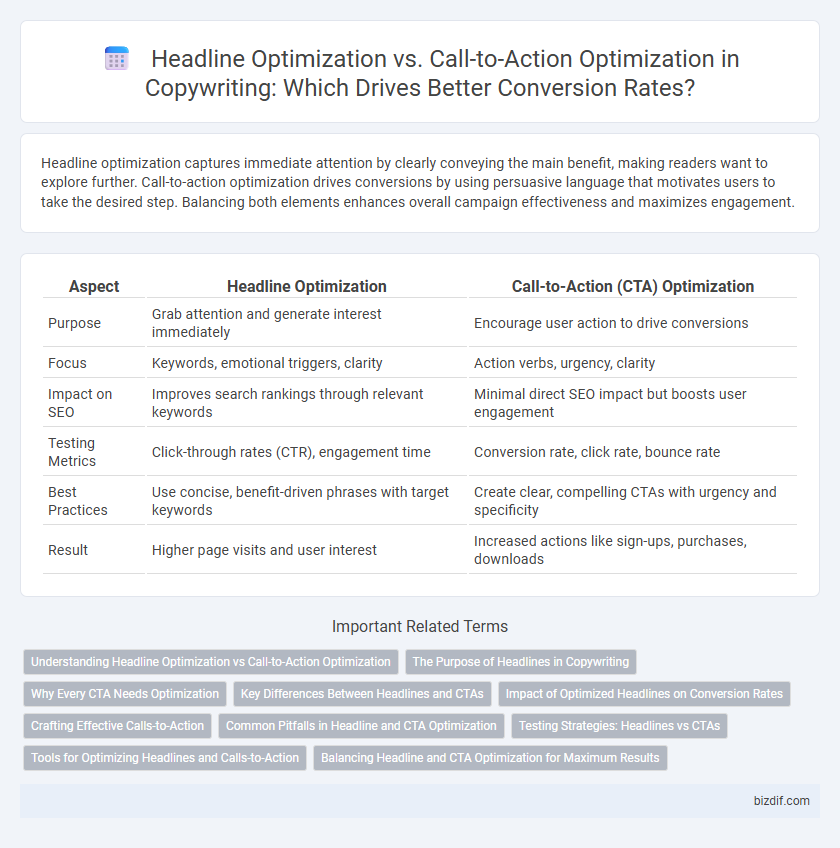Headline optimization captures immediate attention by clearly conveying the main benefit, making readers want to explore further. Call-to-action optimization drives conversions by using persuasive language that motivates users to take the desired step. Balancing both elements enhances overall campaign effectiveness and maximizes engagement.
Table of Comparison
| Aspect | Headline Optimization | Call-to-Action (CTA) Optimization |
|---|---|---|
| Purpose | Grab attention and generate interest immediately | Encourage user action to drive conversions |
| Focus | Keywords, emotional triggers, clarity | Action verbs, urgency, clarity |
| Impact on SEO | Improves search rankings through relevant keywords | Minimal direct SEO impact but boosts user engagement |
| Testing Metrics | Click-through rates (CTR), engagement time | Conversion rate, click rate, bounce rate |
| Best Practices | Use concise, benefit-driven phrases with target keywords | Create clear, compelling CTAs with urgency and specificity |
| Result | Higher page visits and user interest | Increased actions like sign-ups, purchases, downloads |
Understanding Headline Optimization vs Call-to-Action Optimization
Headline optimization focuses on crafting compelling titles that capture attention and improve click-through rates, while call-to-action (CTA) optimization centers on enhancing button text or prompts to increase conversion rates. Effective headline optimization leverages keywords and emotional triggers to drive audience engagement, whereas CTA optimization utilizes action-oriented language and urgency to prompt immediate response. Understanding the distinct roles of headlines and CTAs allows marketers to strategically boost overall campaign performance by aligning messaging with user intent.
The Purpose of Headlines in Copywriting
Headlines in copywriting serve the critical purpose of capturing attention and compelling readers to engage with the content. Unlike Call-to-Action optimization, which drives specific user responses, headline optimization focuses on enhancing readability, relevance, and emotional resonance to increase click-through rates. Effective headlines act as gateways, setting expectations and motivating users to continue exploring the message.
Why Every CTA Needs Optimization
Optimizing every Call-to-Action (CTA) is crucial because CTAs directly drive user engagement and conversions, making them the pivotal element in turning interest into action. Unlike headlines that attract attention, CTAs compel decisive steps such as clicks, sign-ups, or purchases, requiring precise wording, placement, and design to maximize effectiveness. Continuous CTA optimization ensures alignment with audience intent and boosts overall campaign performance by reducing friction and increasing conversion rates.
Key Differences Between Headlines and CTAs
Headlines serve as the initial hook by capturing attention and conveying the core message, while call-to-actions (CTAs) drive user engagement by prompting specific responses or actions. Headlines emphasize clarity and relevance to attract readers, whereas CTAs prioritize urgency and persuasion to convert interest into clicks or purchases. Effective copywriting requires balancing headline optimization for maximum reach and CTA optimization for higher conversion rates.
Impact of Optimized Headlines on Conversion Rates
Optimized headlines significantly increase conversion rates by immediately capturing audience attention and clearly conveying the value proposition, leading to higher engagement. Research shows headlines with strategic keywords and emotional triggers boost click-through rates by up to 50%. Effective headline optimization sets the stage for conversion, making it a critical element before refining call-to-action effectiveness in copywriting campaigns.
Crafting Effective Calls-to-Action
Crafting effective calls-to-action (CTAs) involves using clear, concise language that compels users to take immediate action, such as "Buy Now" or "Sign Up Today." Optimizing CTAs improves conversion rates by creating urgency and highlighting value propositions tailored to target audience needs. While headline optimization grabs initial attention, CTA optimization directly influences user behavior and completion of desired goals.
Common Pitfalls in Headline and CTA Optimization
Common pitfalls in headline optimization include overusing clickbait phrases, which can erode trust, and neglecting keyword relevance, leading to poor search engine ranking. In CTA optimization, vague wording and lack of urgency often cause lower conversion rates because users are unsure what action to take or feel no immediate need to act. Balancing clarity, relevance, and persuasive language is essential to avoid these issues and improve overall copy effectiveness.
Testing Strategies: Headlines vs CTAs
Testing strategies for headline optimization involve A/B testing multiple headline variations to measure engagement metrics such as click-through rates and time spent on the page. In contrast, CTA optimization testing focuses on variations in wording, color, placement, and size to evaluate conversion rates and user actions like sign-ups or purchases. Both methods require systematic experimentation and data analysis to identify the highest-performing elements that drive user interaction and achieve marketing goals.
Tools for Optimizing Headlines and Calls-to-Action
AI-powered tools like CoSchedule Headline Analyzer and Sharethrough Headline Analyzer evaluate headline structure, word balance, and emotional impact to boost engagement and click-through rates. For calls-to-action, platforms such as Unbounce and Optimizely offer A/B testing alongside heatmaps to optimize button text, placement, and design, maximizing conversion rates. Integrating these tools allows marketers to systematically improve both headlines and CTAs, driving stronger campaign performance based on data-driven insights.
Balancing Headline and CTA Optimization for Maximum Results
Balancing headline optimization and call-to-action (CTA) optimization is crucial for maximizing conversion rates in copywriting. Headlines capture initial attention with targeted keywords and emotional triggers, while CTAs drive user engagement through clear, action-oriented language tailored to audience intent. Integrating data-driven testing for both elements ensures synergy, enhancing click-through and conversion metrics effectively.
Headline Optimization vs Call-to-Action Optimization Infographic

 bizdif.com
bizdif.com